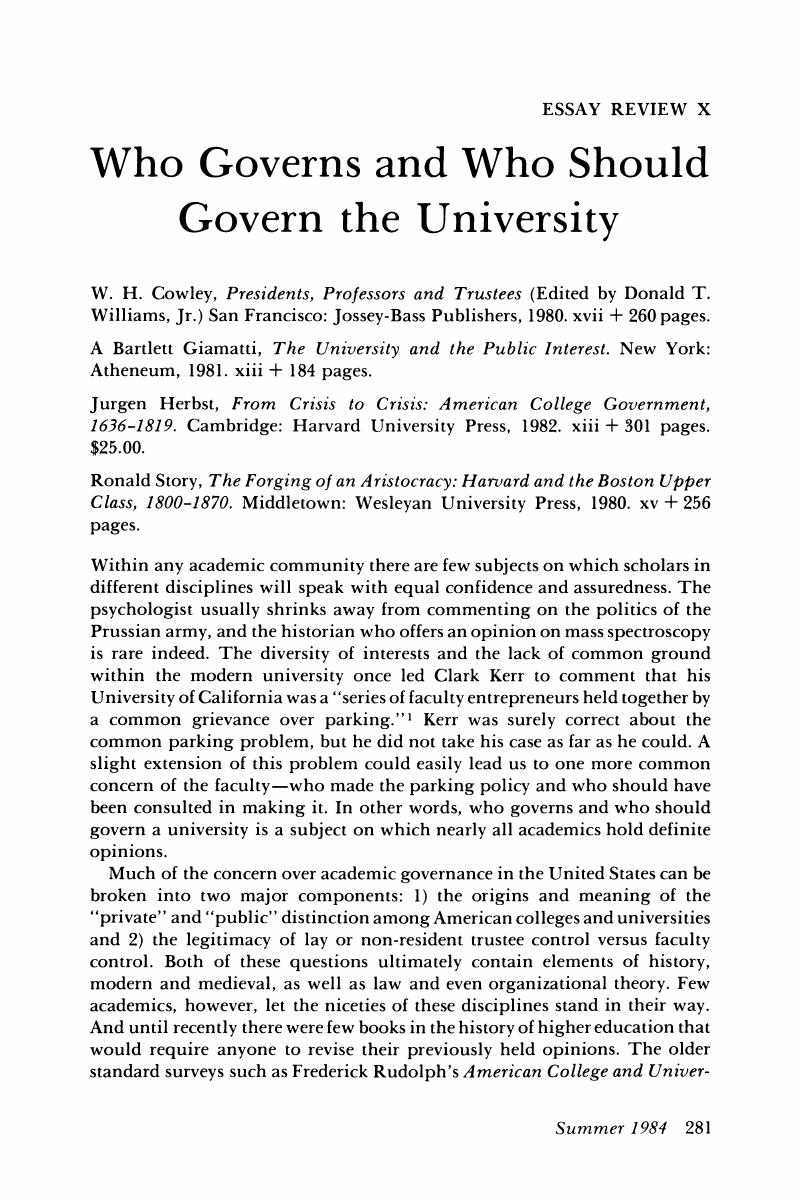No CrossRef data available.
Article contents
Who Governs and Who Should Govern the University
Published online by Cambridge University Press: 24 February 2017
Abstract

- Type
- Essay Reviews
- Information
- Copyright
- Copyright © 1984 by History of Education Society
References
Notes
1. Kerr, Clark, The Uses of the University, (New York 1964) p. 20.Google Scholar
2. Herbst, , From Crisis to Crisis, p. 61.Google Scholar
3. Ibid., p. 128.Google Scholar
4. Ibid., p. 113.Google Scholar
5. Ibid., p. 146.Google Scholar
6. Ibid., p. 189.Google Scholar
7. For an analysis of the traditional interpretations and of my revision see Whitehead, , The Separation of College and State, pp. 53–58.Google Scholar
8. Herbst, , From Crisis to Crisis, p. 243.Google Scholar
9. In this regard a typical recent work is Stites, Francis N., Private Interest and Public Gain: The Dartmouth College Case, 1819 (Amherst, Massachusetts, 1972). Stites notes that the case attracted little attention in 1819. Nonetheless he claims, “The increasing probability of state interference was of considerable concern to denominational colleges, and the college decision provided some assurance of immunity.” (p. 102) But he makes no mention of college which acknowledged this assurance.Google Scholar
10. Boorstin, Daniel, The Americans: The National Experience (New York, 1965), p. 160.Google Scholar
11. Story, , The Forging of an Aristocracy, p. 178.Google Scholar
12. Ibid., p. 181.Google Scholar
13. Ibid., p. 182.Google Scholar
14. Cowley, , Presidents, Professors and Trustees, p. 21.Google Scholar
15. Ibid., p. 185.Google Scholar
16. Ibid., p. 162.Google Scholar
17. Giamatti, , The University and Public Responsibility, p. 3.Google Scholar
18. Ibid., p. 11.Google Scholar
19. Ibid., p. 111.Google Scholar
20. Ibid., p. 114.Google Scholar
21. Ibid., p. 6.Google Scholar
22. The standard work on the spread of denomination colleges is Tewksbury, Donald G., The Founding of American Colleges and Universities Before the Civil War (New York, 1932). For recent scholarship on denominational colleges see Naylor, Natalie, “The Ante-Bellum College Movement: A Reappraisal of Tewksbury's Founding of American Colleges and Universities,” History of Education Quarterly, 13 (1973):261–274; Potts, David, “American Colleges in the Nineteenth Century: From Localism to Denominationalism,” History of Education Quarterly, 11 (1971):363–380; Potts, David, “College Enthusiasm! As Public Response, 1800–1860,” Harvard Educational Review, 47 (1977):28–42; Burke, Colin, American Collegiate Populations: A Test of the Traditional View (New York, 1982).Google Scholar
23. For interpretations of ante-bellum state development which are helpful in this regard see Oscar, & Handlin, Mary, Commonwealth: A Study of the Role of Government in the American Economy: Massachusetts, 1774–1861 (New York, 1947); Hartz, Louis, Economic Policy and Democratic Thought in Pennsylvania 1776–1860 (Cambridge, 1948) and Heath, Milton, Constructive Liberalism: The Role of the State in the Economic Development of Georgia to 1860 (Cambridge, 1954).Google Scholar
24. For the growth of the state connection at Rutgers see McCormick, Richard P., Rutgers: A Bicentennial History (New Brunswick, 1966).Google Scholar
25. Whitehead, , The Separation of College and State, pp. 179–190.Google Scholar
26. For the role of private philanthropy at the University of Virgainia see Debney, Virginius, Mr. Jefferson's University (Charlottesville, Virginia, 1981).Google Scholar
27. The governor, lieutenant governor, and six state senators were added to the Yale Corporation in 1792. The senators were removed in 1871, but the two executives remain in the present day. In the twentieth century the state officials have rarely attended Corporation meetings.Google Scholar


